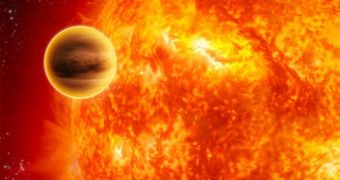Albeit rare, discovering planetary systems featuring two tightly-locked members is nothing new to astronomers. They know that gas giants can interlock their gravitational fields, and thus become trapped in each other's orbit for eternity. But a recent discovery left the international astronomical community puzzled. Experts managed to discover the tightest-bound dual-planet system ever, orbiting close around a parent star that is apparently reaching the end of its burning cycle.
“This is the tightest system that's ever been discovered, and we're at a loss to explain why this happened. This is the latest in a long line of strange discoveries about extrasolar planets, and it shows that exoplanets continuously have this ability to surprise us. Each time we think we can explain them, something else comes along,” explains in a statement the leader of the recent investigation, John Johnson. The expert is an astronomer at the California Institute of Technology (Caltech), in Pasadena. He mentions that the system in question is located relatively close to Earth, some 223 light-years away.
“A planetary system with such closely spaced giant planets would be destroyed quickly if the planets weren't doing such a well synchronized dance. This makes it a real puzzle how the planets could have found their rhythm,” says University of Florida in Gainsville expert Eric Ford, a co-researcher on the investigation. The two planets orbit a dying star called HD 200964, and are both several times more massive than Jupiter. At times, the distance between them can be as short as 33 million miles (53 million kilometers), equal to the distance between Mars and Earth.
“Right now, we're monitoring 450 of these massive stars, and we are finding swarms of planets. Around these stars, we are seeing three to four times more planets out to a distance of about 3 AU [astronomical units] – the distance of our asteroid belt – than we see around main sequence stars,” Johnson adds. He adds that the Sun is a main sequence star, in the sense that it is currently burning hydrogen fuel into helium, via nuclear fusion. When the chemical reaction becomes unsustainable, the star will swell into a red giant, and then diminish into a white dwarf. It will remain in this stage for billions of years, before finally shutting down forever.
The same faith awaits the star that binds the interlocking planetary system. After expelling its atmosphere, it will grow through the red giant phase until its influence throws the gravitational dynamics in the dual-planet system off-balance. “The planets will then move out, and their orbits will become unstable. Most likely one of the planets will get flung out of the system completely,” Johnson believes. Details of the recent investigation have been accepted for publication in a future issue of the esteemed Astronomical Journal, Space reports.

 14 DAY TRIAL //
14 DAY TRIAL //